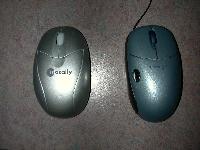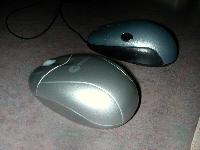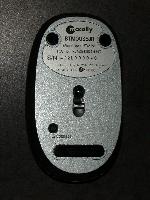Review: Macally BTMouseJr
Following a lengthy search for a good Bluetooth mouse (see entries one and two), someone mentioned the Macally BTMouseJr and the fact that it recently was released. I decided to check it out.
I hadn’t heard much about it, which seems like a marketing blunder considering the demand being generated by new Powerbooks with Bluetooth built-in. Wireless has become an attractive option for laptop users because the surfaces users may work on may not allow for cords. Cords also tangle and are a pain to put away repeatedly. This prompted some companies to come up with solutions for travelers. For example, Kensington made the PocketMouse Pro which features a mechanism to wind the cord within the mouse. The also made a wireless mouse with a compartment to put the USB dongle. Why not use the wireless already built into many laptops, including Windows-based ones? In addition to others, Macally has.
Keep It Simple Stupid
I like to use a Microsoft Intellimouse Explorer with my Powermac, but with its extra buttons, it needs to be a bit larger. Larger is bad when you’re looking for portability. Having to carry around a large heavy mouse with lots of buttons defeats the purpose of a laptop. Therefore, I’m willing deal with less buttons. The BTMouseJr has three buttons: the regular left and right as well as a clickable scroll wheel. The scroll wheel was not negotiable. That, combined with price, made Apple’s Wireless Mouse out of the question. being optical was necessary and at this point should go without saying.
To go along with it’s simplicity, the packaging for the BTMouseJr is very simple. In the box are the mouse, some batteries (yes, batteries are included), and some simple instructions.
Good Things Come in Small Packages
Physically, the mouse is very small.
- Dimensions: (W) 2″ x (L) 3.7″ x (H) 1.3″
- Net Weight: 2.6oz
These dimensions are pretty much par for any portable mouse. As you can see below, the Kensington Pocketmouse Pro is just about the same size as the BTMouseJr.
Snap!
Installation was easy in OS X, using OS X’s built-in Bluetooth device setup assistant. If you’ve used it before, you know how easy it is. If not, Macally’s instructions walk you through it (though it’s self-explanatory enough to be used without). To initiate connection, you simply turn on Bluetooth in your computer and press the “Connect Button” underneath the mouse. Yes, yes, I know I said only three buttons, but this isn’t used other than connecting for the first time.
The scroll wheel glows blue indicating that it’s broadcasting its existence to nearby devices. This blue light holds a double function which I will explain later. During this connecting sequence, it also emits an audible high pitched squeal. This worried me, but thankfully, once the mouse was paired with my computer, the noise stopped. For any potential owners, don’t be worried about this sound.
Batteries Included
Battery usage is particularly important when using a wireless mouse. You don’t want to constantly replace batteries or have them run out at an inopportune time. While most wireless mice rely upon driver software to give you battery status on the computer screen, the BTMouseJr doesn’t. In fact, it doesn’t use any special software. This means that you configure the mouse button action with Apple’s software. By default, the middle button will open new tabs in Safari.
This is where we come full-circle with the scroll wheel. When the batteries start to get low, the light will blink. It will be infrequently at first, then it will become more frequent as time goes on. I went several days with it blinking, so the blinking will give you plenty of time to replace the batteries. The stock batteries were put in July 12th and ran out August 14th. That’s over a month of normal usage on generic batteries (I haven’t figured out how long Energizer or Duracell batteries will last).
To keep battery use at a minimum, the mouse will go to sleep after a certain amount of inactivity (I don’t know how long this is, I’ve never measured it). This poses an interesting question. How does one know when the mouse disconnects and whether it is connected or not without special software. Apple’s Bluetooth software takes care of this. An event bezel will show up (think volume control notification) to indicate the connection is lost. If you don’t see that, you can also use the Bluetooth menu extra to tell. If it is the normal black Bluetooth symbol, then it is disconnected and off. If it’s gray with a dotted black line through it, it’s connected. If the mouse is sleeping, clicking one of the buttons will bring it back to life. Be aware though, that initial click is not ignored, so make sure the pointer is over something that when clicked won’t hinder your work.
Conclusions
I’m thoroughly satisfied with this mouse. At an MSRP of $50 (I found it for $42.20 at Page Computers), it’s much cheaper than Apple’s Wireless mouse.
Pros:
- Only $50 MSRP.
- Silver color perfect for Powerbooks
- Good battery life
- Simple installation
- Small and light
- Sleeps to conserve batteries
Cons:
- No manual on/off switch for travel
- Waking clicks get passed to OS
If you’re looking for a good complement for a Powerbook, the Macally BTMouseJr is a winner.




Comments